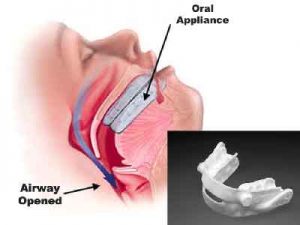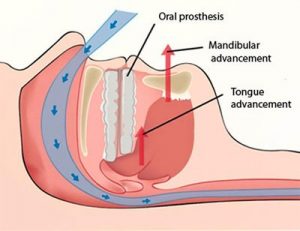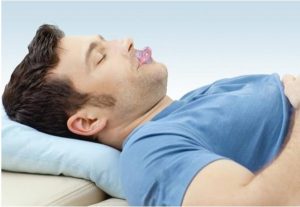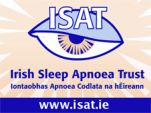Oral Appliances
 Snoring is the sound of partially obstructed breathing which takes place where the airway has narrowed due to a combination of the tongue of the snorer tending to fall back to obstruct the throat and the relaxation of the muscles of the throat relaxing during sleep and for this reason failing to hold the airway open. Treatment to control snoring should ideally perform against both these occurrences as managing one only may not eliminate the problem.Oral appliances have been used to manage snoring for nearly 30 years now. Published data indicates a success rate of 85-90% with a correctly designed and custom-fitted appliance. In my experience success rates are near to 100% in terms of general reduction in snoring to very mild non-intrusive levels or complete elimination.
Snoring is the sound of partially obstructed breathing which takes place where the airway has narrowed due to a combination of the tongue of the snorer tending to fall back to obstruct the throat and the relaxation of the muscles of the throat relaxing during sleep and for this reason failing to hold the airway open. Treatment to control snoring should ideally perform against both these occurrences as managing one only may not eliminate the problem.Oral appliances have been used to manage snoring for nearly 30 years now. Published data indicates a success rate of 85-90% with a correctly designed and custom-fitted appliance. In my experience success rates are near to 100% in terms of general reduction in snoring to very mild non-intrusive levels or complete elimination.
There are two basic designs with slightly different principals of action, the most commonly used being mandibular advancement appliances (MAA) and with tongue retaining devices (TRD) less effective but relatively in-expensive. Appliances need to be fitted by a dentist with experience of the management of snoring and Obstructive Sleep Apnoea (OSA). Problems, although rare, can arise from the wearing of these appliances and most commonly involve temporomandibular joint and muscle pain and other problems. For this reason it is also important that the dentist has experience of the management of these problems.
Very few dentists in Ireland have training in snoring and OSA management in contrast to the USA where there are several thousand dentists involved in this treatment with oral appliances. Once an appliance is provided the improvement is more or less immediate although a period of 3-4 weeks may be required to fine tune the appliance to achieve the best results. Most patients will become comfortable with wearing an appliance within a week or two at most.
Standards of Care (Who may benefit with oral appliances?)
Oral appliances are indicated as the treatment of choice for patients with simple snoring and also those snorers who have mild to moderate sleep apnoea. Many patients who have been advised to wear C-PAP as a way of managing their severe sleep apnoea can not manage to wear their C-PAP masks for various reasons, it may be decided to use oral appliances in these patients and many will find that the appliances will eliminate or at least reduce their apnoea levels to acceptable levels.
Latest studies indicate that the use of oral appliances is probably appropriate as a first line treatment in those with severe OSA. However any person who wishes to switch from the use of C-PAP to an oral appliance would need to have a test with a sleep physician to establish that the oral appliance is controlling their OSA.
Regular after care following the fitting of an oral appliance is essential to ensure there are no problems developing from the wearing of the appliance. It is also imperative that the wearer is checked for the possible return or development of OSA of which the wearer may not be aware. This will usually be achieved with a brief yearly visit to the dentist who provided the appliance.
In summary the following situations are most suitable for oral appliance therapy:
- Primary/heavy snoring (the majority of snorers)
- Mild to moderate sleep apnoea
- Patients who cannot tolerate C-PAP (regardless of their level of apnoea)
- C-PAP users who wish to have a more convenient treatment option whilst travelling Surgery cases that have not resolved
- Surgery cases that have not resolved
Types of Oral Applicance
With so many different oral appliance available, selection of a specific appliance may appear somewhat overwhelming. However nearly all oral appliances fall into one of two categories. The diverse variety is simply a variation of a few major themes. Oral appliances are typically classified according to their mode of action.
Mandibular Advancement Appliances
Mandibular advancement appliances are also sometimes referred to a mandibular repositioning appliances or mandibular advancement devices.They function by holding the lower jaw (mandible) in a slightly forward position during sleep. This serves several functions; it holds the tongue in a forward position preventing it from blocking the airway by falling back into the throat. It tightens the muscles in the area of the soft palate and throat and prevents vibration of the soft palate and the walls of the throat and it widens the throat airway.
Oral appliances are generally custom-made by a dentist with experience and training in their use. A mould is made of the mouth and this results in a very accurate fitting and comfortable appliance with minimal bulk.
 The appliance covers the upper and lower teeth usually with a thin plate of hard plastic with the two plates being linked together. It is important for the sake of comfort that the appliance is not bulky and does not obstruct the tongue or interfere with the passage of air through the mouth, ensuring the wearer can still comfortably breathe through the mouth if required. In some appliances the upper and lower portions of the appliance are sealed together in a pre-determined position. Ideally they should incorporate a simple mechanism to allow the wearer to adjust the degree of forward setting of the lower jaw to allow maximum effectiveness for instance where snoring may return in an individual who has gained weight.
The appliance covers the upper and lower teeth usually with a thin plate of hard plastic with the two plates being linked together. It is important for the sake of comfort that the appliance is not bulky and does not obstruct the tongue or interfere with the passage of air through the mouth, ensuring the wearer can still comfortably breathe through the mouth if required. In some appliances the upper and lower portions of the appliance are sealed together in a pre-determined position. Ideally they should incorporate a simple mechanism to allow the wearer to adjust the degree of forward setting of the lower jaw to allow maximum effectiveness for instance where snoring may return in an individual who has gained weight.
A mandibular advancement appliance is dependent on having a sufficient number of sound teeth in both the upper and lower jaws, ideally a minimum of eight teeth in each jaw. Although it is often possible to have an appliance when there are substantially fewer teeth.
There are a number of very basic mandibular advancement appliances which can be fitted by the individual themselves after placing the appliance in boiling water to soften it and then mould it over the teeth. This inexpensive type of appliance is referred to as a “ boil and bite†appliance. However they are a poor substitute for a custom-made appliance, in that they are usually uncomfortable, easily dislodged and significantly less effective.
Tongue Retaining Devices
 An alternative oral appliance which is suitable for patients who do not have any teeth or have too few teeth to hold a mandibular advancement appliance is a tongue retaining device. With this the tongue is held forward between the teeth with a suction effect. This appliance is less effective than a mandibular advancement appliance in that the tongue only is held in a forward position. However many may get very good results in terms of reducing both snoring and sleep apnoea and it is considerably less expensive.
An alternative oral appliance which is suitable for patients who do not have any teeth or have too few teeth to hold a mandibular advancement appliance is a tongue retaining device. With this the tongue is held forward between the teeth with a suction effect. This appliance is less effective than a mandibular advancement appliance in that the tongue only is held in a forward position. However many may get very good results in terms of reducing both snoring and sleep apnoea and it is considerably less expensive.
Advantages of Oral Appliance Therapy
Oral appliance therapy has several advantages over other forms of therapy:
- Oral appliances are comfortable to wear. Most people find that it only takes a week or so to be acclimatised to wearing the appliance.
- Oral appliances are small and convenient making them easy to carry when travelling.
- Treatment with oral appliances is reversible and non-invasive





